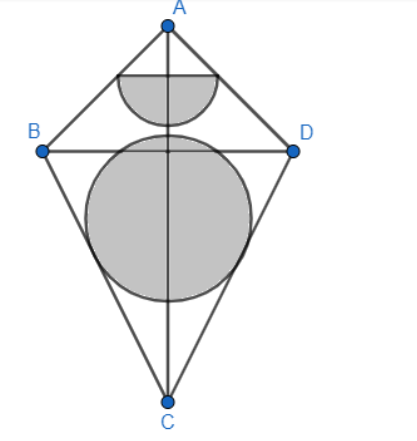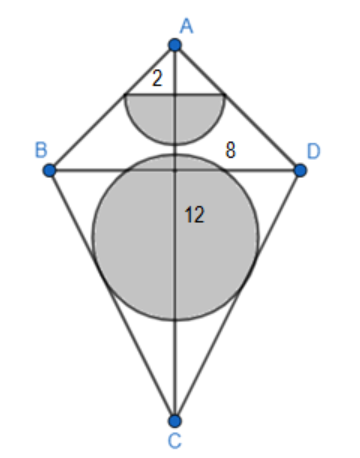
The given figure represents a kite with a circular and a semi-circular motif stuck on it. The radius of the circle is 2.5 cm and the semi-circle is 2 cm. If diagonals AC and BD are of the lengths 12 cm and 8 cm, respectively, find the area of the unshaded part.


Answer
570k+ views
Hint: We know that the area of a kite is equal to the half of the product of its diagonals. Also, we can easily find the area of the circular and semicircular shaded region using the formula $\pi {{R}^{2}}\text{ and }\dfrac{\pi {{r}^{2}}}{2}$ , respectively. So, you just have to find the area of the kite and subtract the area of the shaded regions from it to get the area of the unshaded part.
Complete step-by-step answer:
Let us start the solution to the above question by drawing the diagram.

In the question, it is given in the question that AC=12 cm and BD=8 cm. Also, ABCD is a kite with AC and BD as diagonals. We know that the area of a kite is equal to the half of the product of its diagonals.
$ar\left( ABCD \right)=\dfrac{1}{2}\times AC\times BD=\dfrac{1}{2}\times 12\times 8=48\text{ c}{{\text{m}}^{2}}$
Now moving to find the area of the shaded region. As you can see in the figure that the area of the shaded region is an area of semi-circular added with the area of the circular part.
We know that the area of the semicircular arc is $\dfrac{\pi {{r}^{2}}}{2}$ , where r is the radius of the semi-circle and is equal to 2cm. Also, we know area of the circular part with radius R=2.5cm is given by $\pi {{R}^{2}}$ .Therefore, we get
Area of the shaded region= \[\dfrac{\pi \times {{\left( 2 \right)}^{2}}}{2}+\pi {{\left( 2.5 \right)}^{2}}=\pi \left( 2+6.25 \right)=8.25\pi \]
Now, if we put the value of $\pi $ as 3.14, we get
Area of the shaded region= \[8.25\times 3.14=25.90\text{ c}{{\text{m}}^{2}}\]
Now, if we subtract the area of the shaded region from the area of the kite, we get the area of the unshaded region.
Area of the unshaded region = Area of kite ABCD - Area of shaded region
Area of the unshaded region = 48 - 25.90 = 22.10 sq cm.
Therefore, we can conclude that the area of the unshaded region is 22.10 sq cm.
Note: Be careful in the calculation part and learn all the formulas related to different types of quadrilaterals like kite, parallelogram etc. and be sure that you don’t confuse the area of the kite with the formula $\dfrac{1}{2}\times \left( \text{sum of diagonals} \right)$ instead of the correct formula $\dfrac{1}{2}\times \left( \text{product of diagonals} \right)$ . Also, learn all the formulas related to the area and perimeter of the circle. The other possibilities of making a mistake includes misreading the question and finding the area of the shaded region instead of the unshaded region.
Complete step-by-step answer:
Let us start the solution to the above question by drawing the diagram.

In the question, it is given in the question that AC=12 cm and BD=8 cm. Also, ABCD is a kite with AC and BD as diagonals. We know that the area of a kite is equal to the half of the product of its diagonals.
$ar\left( ABCD \right)=\dfrac{1}{2}\times AC\times BD=\dfrac{1}{2}\times 12\times 8=48\text{ c}{{\text{m}}^{2}}$
Now moving to find the area of the shaded region. As you can see in the figure that the area of the shaded region is an area of semi-circular added with the area of the circular part.
We know that the area of the semicircular arc is $\dfrac{\pi {{r}^{2}}}{2}$ , where r is the radius of the semi-circle and is equal to 2cm. Also, we know area of the circular part with radius R=2.5cm is given by $\pi {{R}^{2}}$ .Therefore, we get
Area of the shaded region= \[\dfrac{\pi \times {{\left( 2 \right)}^{2}}}{2}+\pi {{\left( 2.5 \right)}^{2}}=\pi \left( 2+6.25 \right)=8.25\pi \]
Now, if we put the value of $\pi $ as 3.14, we get
Area of the shaded region= \[8.25\times 3.14=25.90\text{ c}{{\text{m}}^{2}}\]
Now, if we subtract the area of the shaded region from the area of the kite, we get the area of the unshaded region.
Area of the unshaded region = Area of kite ABCD - Area of shaded region
Area of the unshaded region = 48 - 25.90 = 22.10 sq cm.
Therefore, we can conclude that the area of the unshaded region is 22.10 sq cm.
Note: Be careful in the calculation part and learn all the formulas related to different types of quadrilaterals like kite, parallelogram etc. and be sure that you don’t confuse the area of the kite with the formula $\dfrac{1}{2}\times \left( \text{sum of diagonals} \right)$ instead of the correct formula $\dfrac{1}{2}\times \left( \text{product of diagonals} \right)$ . Also, learn all the formulas related to the area and perimeter of the circle. The other possibilities of making a mistake includes misreading the question and finding the area of the shaded region instead of the unshaded region.
Recently Updated Pages
How do you convert r6sec theta into Cartesian form class 10 maths CBSE

How do you solve dfrac5y3dfracy+72y6+1 and find any class 10 maths CBSE

If sin A+B1 and cos AB1 0circ le left A+B rightle 90circ class 10 maths CBSE

On the number line 10 is to the of zero class 10 maths CBSE

How do you solve 5xge 30 class 10 maths CBSE

In the following sentence supply a verb in agreement class 10 english CBSE

Trending doubts
Write an application to the principal requesting five class 10 english CBSE

Why is there a time difference of about 5 hours between class 10 social science CBSE

Write a letter to the principal requesting him to grant class 10 english CBSE

The Equation xxx + 2 is Satisfied when x is Equal to Class 10 Maths

What is the median of the first 10 natural numbers class 10 maths CBSE

Write examples of herbivores carnivores and omnivo class 10 biology CBSE




